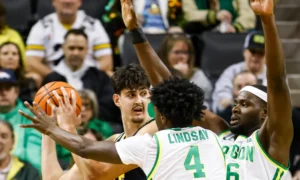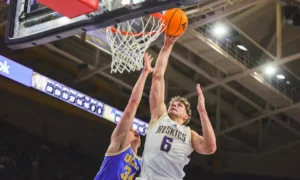With the official start of practice quickly approaching, UM Hoops and Inside the Hall have again partnered to bring you a preseason breakdown of the top 25 players in the Big Ten for the 2018-2019 season.
Our selection process involved much deliberation to arrive at a list we hope will provide plenty of reaction and debate. The series will be broken into five parts and our fourth installment of players 10-6 is available below. Previously: 25-21, 20-16, 15-11
Get UM Hoops for 2018-19. For a limited time only, sign up with the promo code TOP25 to get an annual membership for less just $32. That’s just $2.66 per month for complete coverage of Michigan basketball.
10. Tyler Cook, Iowa (6-foot-9, forward, junior)
In terms of a raw talent, Cook could rank even higher on this list. He has moments of basketball brilliance on the floor, but he also seems to get lost in the shuffle on Fran McCaffery’s endless bench at times. Cook averaged 15.3 points and 6.8 rebounds per game as a sophomore and posted six 20-point performances in league play. Only two league players (with at least 100 possessions) scored the ball more efficiently than Cook in one-on-one post up situations. Cook is also a capable scorer when he faces up and should be poised for a big junior year after testing the NBA waters in the spring. The Hawkeyes return a significant amount of talent and Cook figures to play a large part in any turnaround this year.
9. Jordan Murphy, Minnesota (6-foot-6, forward, senior)
An undersized power player, Jordan Murphy has been one of the Big Ten’s best rebounders since arriving on campus. As a junior, Murphy averaged a double-double (16.8 ppg, 11.3 rpg) and led the nation with 24 double-doubles. He ranked in the top five in league games in both offensive and defensive rebounding percentage, but struggled with his efficiency. Murphy shot just 48.7 percent on 2s last season against Big Ten opponents. Still, his motor and tenacity on the glass makes him one of the league’s premier frontcourt players entering his final season. With a potentially better stable of bigs to surround him with this season in Minneapolis, Richard Pitino will likely rely heavily on Murphy’s production in the paint to help guide him back into the good graces of the Minnesota fanbase.
8. Charles Matthews, Michigan (6-foot-6, guard, redshirt junior)
Matthews flirted with the NBA Draft before opting to return to school for his second year in a Michigan uniform. His redshirt sophomore season saw ups and downs including some ugly Big Ten stats — 46% on 2s, 29% on 3s — but he figured out how to put things together in the Big Ten and NCAA Tournaments. Matthews needs to improve his perimeter shot (31% last year) and cut down on his turnovers, but he’ll have to try to make those offensive improvements without his most reliable offensive teammates from a season ago. The 6-foot-6 athlete was an integral part of Michigan’s breakout defense last year and should anchor another impressive defensive unit this year next to Zavier Simpson. If he does become a more efficient offensive player, he could very well play himself into the first round of next year’s NBA Draft.
7. Anthony Cowan Jr., Maryland (6-foot, guard, junior)
Cowan might be one of the Big Ten’s most underrated and under appreciated players. No Big Ten player took on a heavier workload than Cowan did as a sophomore in College Park as he played 96.7 percent of available minutes in league play. Despite a disappointing season for Maryland that resulted in a complete miss of postseason play, Cowan Jr. proved himself to be one of the league’s best lead guards and won defensive player of the year. His assist rate of 30.1 percent in conference games ranked fourth best and he also shot an efficient 39.8 percent on 3s. In addition, he ranked 11th in steal percentage and sixth in free throw rate in Big Ten games. With Kevin Huerter moving onto the NBA, there will be added pressure on Cowan to take on even more of a load as a junior. Given the 15.8 points, 5.1 assists and 4.4 rebounds he produced per game last season, he looks to be more than ready for that challenge.
6. Romeo Langford, Indiana (6-foot-6, guard, freshman)
Langford was one of the most difficult prospects to place on this year’s list. If we were ranking solely by talent or NBA draft potential, he would be the surefire No. 1. The Indiana Mr. Basketball and McDonald’s All-American is the highest rated player nationally to enter the conference since Jared Sullinger signed with Ohio State in 2010. And while we fully expect Langford to produce at a high level from day one in Bloomington, there will still be ups and downs as he adjusts to the rigors of the college game. Langford’s ability to score the ball from the perimeter, at the rim and in transition gives Indiana a scoring threat that last year’s team didn’t possess. Defensively, his size and length give him the potential to develop into a disruptive two-way player with a chance to outperform this lofty preseason ranking.

Notable Replies
Discuss the Article
33 more replies









gtfomycourt
Zavier Simpson,
You are unranked and Winston is considered top 5. Let that sink in, then,as you did last year, show us again why many of us are glad to have you, leading our team, instead of Winston.
romeowolv
I vehemently disagree with any list that has Winston as a top 10 player.
RedsMaizeandBlue
There’s some serious underrating of Winston happening here. Winston’s offensive numbers are absolutely nuts. 50% from three on 150 attempts, 52% on twos, 7 assists a game. He also just so happens to be a WAY below par defender and Zavier has his number. He’s basically the complete inverse of Zavier. As a predictor, I actually disagree with Winston being top five. I think he will see a lot more defensive attention without Bridges and JJJ which will open up Langford. But if you’re looking at stats and the fact that he is almost surely the top guy at MSU, I put him top ten in the Big Ten pretty easily.
This has no correlation to Simpson being in the top 25, I think he is easily, probably top 20, and the question to ask relating to that is would you rather have Zavier Simpson, or Trent Frazier? I take Simpson, zero hesitation.
gtfomycourt
I agree with the idea that Z is the inverse of Winston.
I also agree that Winston is a great offensive player. For me, it boils down to comparing Winston’s defense to Z’s outside shooting. Z’s outside shooting is not good but luckily Z can refrain from shooting from the outside a lot and to some extent hide his weakness. Winston’s defense is horrible (!) and unfortunately for him, and MSU, refraining from defending will not hide his weakness. Winston is hurting his team 50% of the time he is on the floor…
Between Winston, Loyer, Langford and to some extent Mcquaid. I can’t think of a worse defending backcourt on any big ten team. Ever. It is going to be bad. Very bad.
DeAngeloVickers
The issue though is the impact of an individual offensive player is more important than an individual defensive player.
A great offensive player can take over a game. A great defensive player can force the other team to adjust (and possibly avoid their first option). So here the great offensive player helps the team more than the great individual defensive player.
On the other side of the ball, a poor offensive player means your team has to essentially play 4 on 5 (this is the Lourawls Nairn scenario), and the defense can help. A poor defensive player can be hidden by defensive tactics such as zone, switching, or matching up with opposing teams worst option. Again, here the poor offensive player hurts the team more than the poor defensive player.